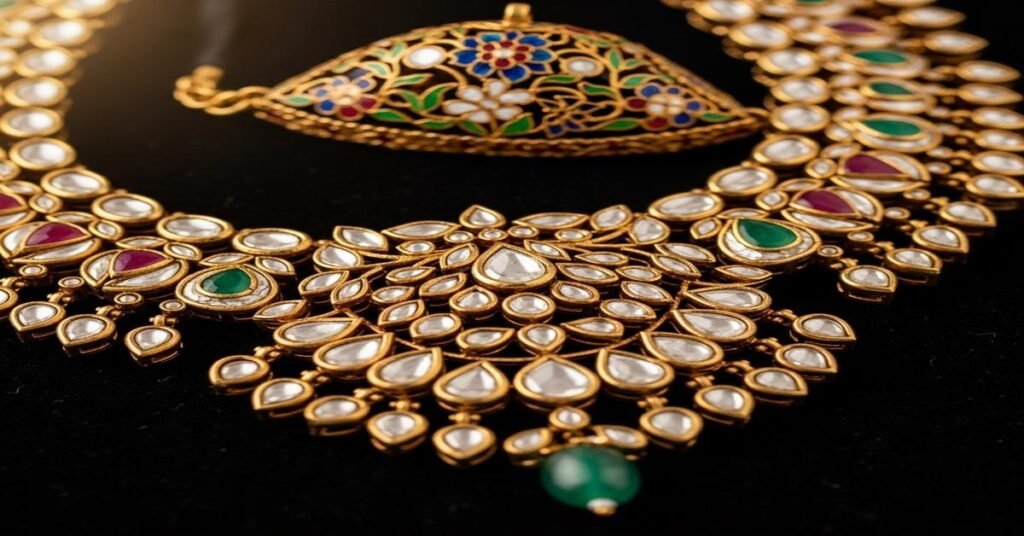Jadau is a centuries-old Indian jewelry technique that literally means “to join.” It creates richly ornamented pieces—often bridal necklaces and heavy chokers—by embedding uncut gems and glass into gold. The result is a flat, gleaming surface of stones held flush by gold foil and finished with colorful enamel. The method is hand-driven and labor-intensive. That craftsmanship is why authentic jadau commands both cultural and monetary value.
A short history
Jadau developed under Mughal patronage in the 16th–18th centuries and grew in Rajasthan and Gujarat. Royal courts and Rajput brides favored it because the look is bold and formally symmetrical. Over time, regional centers—especially Jaipur and Kutch—added local tastes like floral motifs and meenakari (enamel) on the reverse. Historically, artisans used high-carat gold and polki (uncut diamonds), which required a cold-setting method to avoid heat damage to the stones.
Materials and tools
- Gold alloy: The structural frame is usually 22K gold (91.6% pure). The thin foil used to finish and secure stones—called kundan—is often 23–24K gold for its malleability and bright color.
- Gemstones: Polki (uncut diamonds), rubies, emeralds, and semi-precious stones are common. Polki stones range from 0.1 ct to several carats and sizes of about 2–10 mm across are typical.
- Lac (natural resin): Sourced from lac insects, this resin softens when gently heated (around 80–100 °C) and forms the initial bed for stones. It’s organic, so it needs specific care later.
- Tools: Agate burnishers, small wooden mallets, tweezers, fine files, and enamel brushes. No soldering or intense heat is applied where the stones sit.
Step-by-step: How jadau is made
- Design and frame making: The jeweler sketches the motif and fabricates a solid gold frame or tray. For durability, frames are often 22K and 1–2 mm thick in critical areas.
- Preparing seats: Small cavities or seats are carved into the frame to accept each stone. Seats are sized to the stone—example: a 5 mm polki needs a 5.0–5.2 mm seat to fit snugly.
- Applying lac: Lac is heated just enough to become tacky. The artisan places a small pellet into each seat and presses it to form a cushion. This holds the stone without heat, which protects sensitive gems.
- Cold-setting the stones: The stone is placed on the lac cushion and carefully seated. This preserves clarity and prevents cracks in uncut stones. The process is slow—setting a single polki precisely can take several minutes.
- Applying kundan foil: Thin gold foil (23–24K) is cut and placed over the edges of the seated stone from the front or back, depending on design. The foil is hammered and burnished with agate tools to fold tightly around the stone’s girdle and lock it in place.
- Finishing the reverse with meenakari (optional): Many jadau pieces feature enamel work on the underside. Artisans paint colors (red, green, blue) into recessed areas and fire them at low temperature on a charcoal bed so enamel fuses without stressing the stones.
- Polishing and inspection: The piece is cleaned, polished, and every seat is checked. Missing lac or loose kundan foil gets reworked. A simple earring may take several hours; a complex bridal set can require several weeks by a team of craftsmen.
Why the cold-setting method matters
Cold-setting prevents heat-related damage to uncut or fracture-prone stones. Polki stones and some colored gems contain inclusions and internal structures that crack under flame. Lac plus kundan foil secures each gem mechanically rather than with solder or adhesive. That is the technical reason jadau looks seamless and flat while keeping stones intact.
How to identify authentic jadau and how to care for it
- Authenticity checks: Ask for the gold carat (22K frame, and whether foil is 23–24K). Insist on hallmarking for gold weight. True jadau will show fine tooling marks on the reverse and often meenakari enamel beneath the stones.
- Common imitations: Lightweight jadau-style pieces may use brass or silver base, gold plating, or glue instead of lac. These are cheaper and less durable. If the piece is very light but shows heavy stone work, it’s likely a modern imitation.
- Care: Avoid steam cleaners or ultrasonic baths—lac is organic and will soften. Clean gently with a soft brush and mild soapy water, then pat dry. Store flat, wrapped in soft cloth to prevent pressure on stones. Have a trusted jeweler inspect lacquer and foil every 2–3 years.
Value drivers and modern trends
Price depends on gold weight (grams at 22K), total carat weight of polki or other gems, and hours of handwork. For example, a traditional bridal necklace can weigh 80–200 grams of gold; that alone sets a base cost. Polki stones, because they are uncut and rare, add premium pricing per carat compared with similar modern-cut diamonds of similar clarity.
Contemporary designers are making lighter jadau using hollow frameworks or by combining jadau elements with lighter gold alloys (18K), allowing more wearable daily pieces. Lab-grown gemstones and certified recycled gold are also entering the category, offering lower-cost or ethical alternatives while retaining the jadau look. When buying, request a detailed invoice listing gold carat, gross weight, and stone descriptions.
Jadau is an artisanal technique where heritage, materials, and method all shape value. Knowing the steps and materials helps you judge authenticity, care for the piece, and appreciate why genuine jadau remains a high-skill craft rather than a simple decorative finish.
I am G S Sachin, a gemologist with a Diploma in Polished Diamond Grading from KGK Academy, Jaipur. I love writing about jewelry, gems, and diamonds, and I share simple, honest reviews and easy buying tips on JewellersReviews.com to help you choose pieces you’ll love with confidence.

